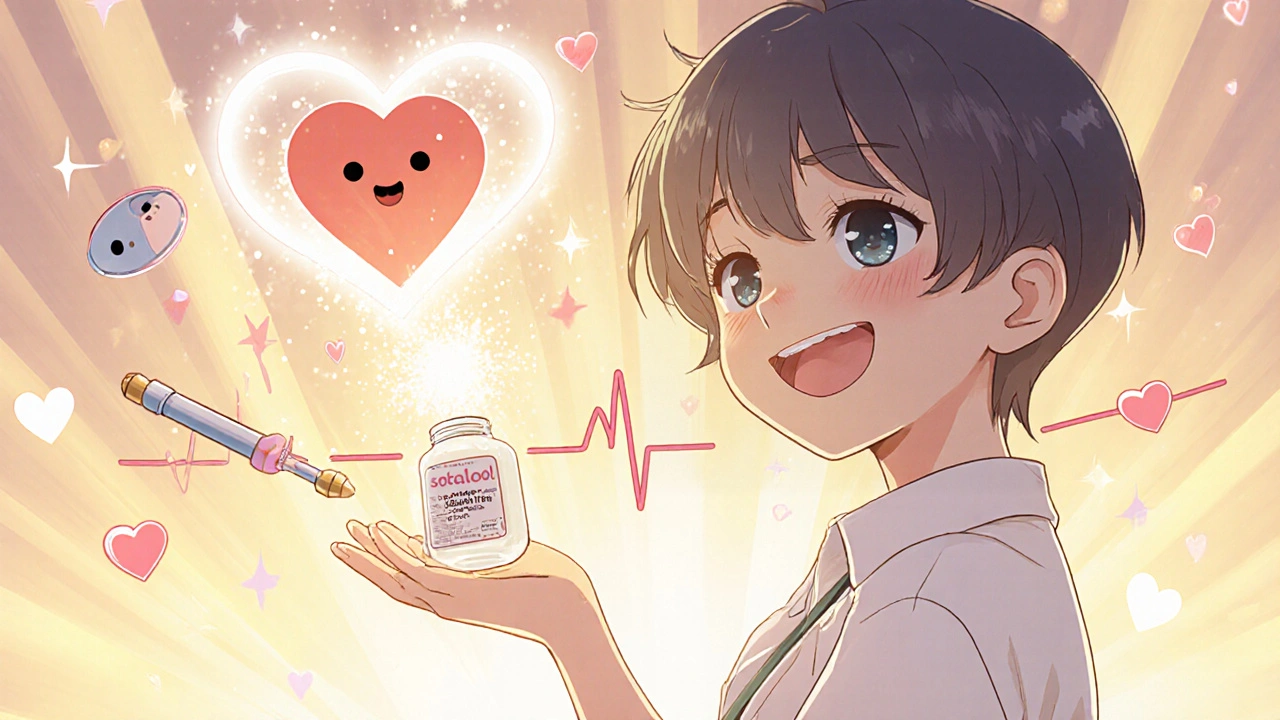Heart Rhythm Treatment Decision Tool
Personalized Treatment Assessment
This tool helps identify the most appropriate heart rhythm treatment options based on your specific health profile. It is not medical advice. Always consult your cardiologist before making treatment decisions.
Your Treatment Options
Recommended Medication
Key Considerations
When your heart skips, races, or flutters out of rhythm, finding the right medication can feel like searching for a key in a dark room. Betapace, the brand name for sotalol, has been a go-to for decades to treat serious heart rhythm disorders like atrial fibrillation and ventricular tachycardia. But it’s not the only option-and for many people, it’s not the best one. Side effects, dosing complexity, and safety risks mean doctors often look elsewhere. So what are the real alternatives? And how do they stack up against sotalol in real-world use?
What Betapace (Sotalol) Actually Does
Sotalol is a dual-action drug: it slows your heart rate like a beta-blocker and prolongs the electrical recovery phase of heart cells like a Class III antiarrhythmic. This makes it effective at restoring normal rhythm and preventing dangerous arrhythmias. But that same power comes with serious trade-offs. The FDA warns that sotalol can cause a type of irregular heartbeat called torsades de pointes, especially in people with low potassium, kidney problems, or those taking other QT-prolonging drugs. About 1 in 20 patients on sotalol will experience a significant rhythm problem within the first few days of starting it. That’s why many hospitals require patients to begin sotalol under cardiac monitoring.
Amiodarone: The Heavyweight with Heavy Costs
If sotalol is a strong contender, amiodarone is the heavyweight champion-with a lot of baggage. It’s more effective than sotalol at keeping the heart in rhythm, especially in people with structural heart disease. One large study showed amiodarone reduced arrhythmia recurrence by 45% over two years, compared to 30% with sotalol. But amiodarone doesn’t just affect the heart. It builds up in your liver, lungs, thyroid, and skin. Long-term use can lead to lung scarring, thyroid dysfunction, and permanent blue-gray skin discoloration. It also takes weeks to reach full effect and can interact with dozens of other medications. For many, it’s a last-resort option because of these risks.
Dronedarone: Safer, But Less Powerful
Dronedarone was developed to be the cleaner version of amiodarone-same benefits, fewer side effects. It’s approved for paroxysmal or persistent atrial fibrillation in patients without severe heart failure. Studies show it cuts hospitalizations for arrhythmias by about 25%, but it’s not as strong as sotalol or amiodarone at maintaining normal rhythm. The big win? It doesn’t cause lung or thyroid damage like amiodarone. But it’s not for everyone. If you have New York Heart Association Class IV heart failure, dronedarone can increase your risk of death. And it still carries a small risk of QT prolongation, so you still need regular ECGs. It’s a middle-ground drug: safer than sotalol in some ways, less effective in others.

Flecainide and Propafenone: Fast-Acting, But Risky in Diseased Hearts
Flecainide and propafenone are Class Ic antiarrhythmics. They work fast to reset the heart’s rhythm and are often used for paroxysmal atrial fibrillation in people with otherwise healthy hearts. They’re not approved for patients with coronary artery disease or heart failure because they can trigger deadly arrhythmias in those with damaged heart tissue. But for a 58-year-old with no heart disease and occasional AFib episodes, they can be a game-changer. Unlike sotalol, they don’t slow the heart rate, so you won’t feel sluggish. But if you have even mild heart scarring, these drugs can be dangerous. Your doctor will likely order an echocardiogram before prescribing them.
Cardiac Ablation: The Non-Drug Alternative
Medications aren’t the only path. Catheter ablation, a minimally invasive procedure, uses heat or cold to destroy small areas of heart tissue causing the abnormal rhythm. For many people with paroxysmal atrial fibrillation, ablation is more effective than any drug over the long term. A 2023 trial showed that after one year, 70% of patients who had ablation were free from arrhythmias without medication, compared to 30% on sotalol. The procedure isn’t risk-free-there’s a 1-2% chance of serious complications like stroke or heart perforation-but for younger, active patients tired of daily pills and side effects, it’s becoming the preferred first-line option. Many now choose ablation before trying multiple drugs.
How Doctors Decide Between Them
There’s no universal answer. The choice depends on your heart’s condition, your age, other health issues, and what you’re willing to tolerate. Here’s how it typically breaks down:
- If you have healthy heart tissue and occasional AFib: Flecainide or propafenone may be tried first. They’re fast, effective, and don’t cause fatigue.
- If you have structural heart disease or heart failure: Amiodarone or sotalol might be used, but only with close monitoring. Dronedarone is often avoided here.
- If you’re young and want to avoid lifelong meds: Ablation is increasingly the first choice, especially if you’ve had one or two failed drug trials.
- If kidney function is poor: Sotalol is cleared by the kidneys, so it’s risky if your eGFR is below 40. Dronedarone and flecainide are safer in this group.
Some patients try sotalol first because it’s cheaper and widely available. But if you’re on it for more than three months and still having episodes-or you’re feeling dizzy, tired, or short of breath-it’s time to talk about switching.

Real-World Trade-Offs No One Talks About
Sotalol requires twice-daily dosing. Miss a dose, and your rhythm can destabilize. You need blood tests for potassium and kidney function every few months. You can’t take it with antacids or certain antibiotics without risking dangerous interactions. Many patients say they feel like a lab rat-constantly being monitored, adjusting doses, fearing side effects.
Amiodarone users talk about the weight gain, the sensitivity to sunlight, and the constant worry about thyroid problems. Dronedarone users say it’s better, but they still feel occasional palpitations. Flecainide gives freedom from fatigue but requires strict avoidance of alcohol and grapefruit juice. And ablation? It’s a one-time procedure, but recovery takes weeks. You can’t drive for a few days. You might need to take time off work. But for many, the trade-off is worth it: no more pills, no more blood tests, no more fear of sudden arrhythmia.
What Works Best for You?
There’s no single best drug. The right choice depends on your body, your lifestyle, and your goals. If you want the strongest rhythm control and can handle the risks, amiodarone wins. If you want something simpler and safer with moderate effectiveness, dronedarone is a solid pick. If you have a healthy heart and want fast relief without fatigue, flecainide might be ideal. If you’re ready to break free from daily meds, ablation is no longer a last resort-it’s a first option.
Don’t just accept sotalol because it’s what your doctor first prescribed. Ask: Is this working? Is it making me feel worse? Are there better options? Your heart rhythm matters. So does your quality of life.
Can I switch from Betapace to another drug on my own?
No. Stopping or switching antiarrhythmic drugs like sotalol without medical supervision can trigger life-threatening arrhythmias. These medications must be tapered slowly under cardiac monitoring. Never change your dose or switch drugs without talking to your cardiologist first.
Is sotalol better than amiodarone?
Amiodarone is more effective at maintaining normal heart rhythm, especially in people with heart disease. But sotalol has fewer long-term organ side effects. Amiodarone can damage your lungs, thyroid, and liver over time. Sotalol mainly affects the heart’s rhythm and kidneys. The choice depends on your health profile and how long you need treatment.
Why do some people get torsades de pointes on sotalol?
Torsades de pointes is a dangerous type of ventricular arrhythmia linked to prolonged QT intervals on an ECG. Sotalol can lengthen the QT interval, especially if you have low potassium, low magnesium, kidney problems, or take other QT-prolonging drugs. That’s why doctors check your electrolytes and ECG before and after starting sotalol, and why it’s often started in the hospital.
Can I take sotalol if I have kidney disease?
Sotalol is cleared mostly by the kidneys. If your kidney function is reduced (eGFR below 40), your body can’t clear the drug properly, increasing the risk of overdose and dangerous rhythms. Doses must be lowered, or an alternative like dronedarone or flecainide may be preferred. Always tell your doctor if you have kidney issues before starting sotalol.
Is ablation better than medication for atrial fibrillation?
For many patients, especially those under 70 with paroxysmal AFib and no major heart disease, ablation is more effective than medication at keeping the heart in rhythm long-term. Studies show over 70% of patients remain free from arrhythmias after one ablation, compared to about 30% on drugs like sotalol. While ablation has risks, many find the long-term freedom from pills and monitoring worth it.
Next Steps if You’re on Betapace
If you’re currently taking sotalol, ask yourself these questions: Are you still having palpitations or dizziness? Do you feel tired all the time? Have you had your potassium or kidney levels checked in the last three months? If you answered yes to any of these, it’s time to talk to your doctor. Bring a list of your symptoms, your medication schedule, and your questions. Ask about alternatives like dronedarone, flecainide, or whether ablation could be right for you. Don’t wait until something goes wrong. Your rhythm matters-not just for your heart, but for your life.







Arrieta Larsen
October 29, 2025I was on sotalol for 8 months and felt like a zombie. Like, I couldn’t walk up the stairs without gasping. My doctor said it was ‘normal’-but it wasn’t. Switched to dronedarone and suddenly I could breathe again. No more weird heart skips either. Don’t let them gaslight you into thinking fatigue is just part of aging.
Also, potassium levels? Check them monthly. I didn’t and nearly ended up in the ER. Just sayin’.